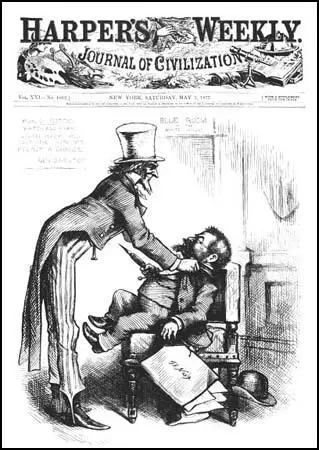Harper's Weekly
In 1817, two young brothers, James Harper (22) and John Harper (20), established a small printing firm in New York. Two other brothers, Joseph Harper and Fletcher Harper, joined the company and by 1825 Harper & Brothers was the largest book publisher in the United States.
Fletcher Harper became aware of the success in Britain of the London Illustrated News. In 1850 he launched Harper's Monthly. Edited by Henry Raymond, the journal initially concentrated on publishing established authors such as Charles Dickens and William Thackeray. The venture was a great success and in 1857 the company also began publishing Harper's Weekly.
By 1860 the circulation of Harper's Weekly had reached 200,000. The cartoonist, Thomas Nast, was recruited two years later and he was to remain with the magazine for over twenty years. During this period Nast began to distort and exaggerate the physical traits of his subjects and therefore played an important role in the development of political caricature. Nast also originated the idea in America of using animals to represent political parties. In his cartoons the Democratic Party was a donkey and the Republican Party, an elephant. He also helped to develop the character, Uncle Sam, to represent the United States.
Harper's Weekly took a moderate editorial stance on the issue of slavery. The main reason was that the editor did not want to upset its considerable readership in the South. Radical Republications criticized the journal for this and it was described by them as Harper's Weakly. The journal supported Stephen A. Douglas in the 1860 presidential election but after the outbreak of the American Civil War it loyally supported Abraham Lincoln and the Union.
After the war Harper's Weekly supported the Republican Party and played an important role in the election of Ulysses Grant in 1868 and 1872. In the 1870s Thomas Nast concentrated his attacks in the journal on William Tweed, the corrupt political leader of New York City. Nast refused an offer of a $200,000 bribe to end this campaign and eventually in 1876 Tweed was arrested and imprisoned for fraud.

Thomas Nast and Harper's Weekly also played an important role in securing victory for Rutherhood Hayes in 1876. Afterwards Hayes commented that Nast was "the most powerful single-handed aid we had." In 1884 Nast changed sides and supported the Democratic candidate, Grover Cleveland for president. In doing so, he helped Cleveland become the first Democrat president since 1856. After this, Nast was known as the "presidential maker".
In the late 19th century Harper's developed a reputation for employing top illustrators such as Frank Bellew, Charles Dana Gibson, Fred Repington, Howard Pyle, James M. Flagg and Maxfield Parrish.
After 1900 the magazine devoted more space to political and social issues and featured articles by political figures such as Carl Schurz, Theodore Roosevelt and Woodrow Wilson.
